Peru is a country that holds centuries of history, culture, and mysteries waiting to be discovered. From the majestic Inca ruins in the Andean heights to the traces of pre-Columbian civilizations in the coastal desert, every corner of this land tells a unique story.
In this blog, we will explore nine historic sites in Peru that will not only surprise you with their beauty but also connect you to the ancestral legacy that defines the identity of this South American country. Get ready to embark on an unforgettable journey to the heart of Peruvian history and culture!
Why visit the historical sites of Peru?
Peru is the ideal destination if you’re a history lover, an archaeology enthusiast, or simply seeking authentic travel experiences. Here, you will find an incomparable cultural heritage protected by UNESCO and valued worldwide. Each historic site offers breathtaking landscapes and allows you to immerse yourself in the past and understand how these civilizations shaped the history of Latin America.
Let’s begin discovering these Peruvian treasures!
1. Machu Picchu
Machu Picchu, the famous lost city, is one of the most iconic tourist destinations in the world and the most famous archaeological site in South America. Located in the Cusco region of Peru, this Inca citadel combines history, mystery, and stunning landscapes, making it a must-visit for any traveler. Built-in the 15th century and rediscovered in 1911 by Hiram Bingham, this historical gem rises above the clouds, surrounded by mountains and the jungle of the Urubamba Valley, offering a unique experience that takes you back in time.
Brief Description
A stone citadel is considered a masterpiece of Inca architecture. It was built by the Inca civilization during the reign of Emperor Pachacuti, around the mid-15th century. This sacred place symbolizes the Incas’ innovation and spirituality, reflecting their advanced knowledge in engineering, astronomy, and architecture.
Location and How to Get There
- Region: Cusco, Peru.
- Closest City: Aguas Calientes, also known as Machu Picchu Pueblo.
Transportation Options
- By Train: Take the train from Cusco or Ollantaytambo to Aguas Calientes. This is the most popular and comfortable option.
- On Foot: The 4-day hike through the Inca Trail is considered one of the best trekking routes in the world.
- By Bus: From Aguas Calientes to the entrance of the citadel. You can also choose to walk this stretch (about 1.5 hours).
Best Time to Visit
- Dry Season (May to September): This season is ideal for sunny days and less chance of rain. However, it is also the busiest season, so booking tickets and transportation months in advance is recommended.
- Rainy Season (October to April): Though less visited, the wet weather, with clouds enveloping the mountains, adds a mystical touch.
Highlights of Machu Picchu
- Unique Features:
- Advanced Engineering: The stones are perfectly fitted without mortar, withstanding centuries of earthquakes and erosion.
- Agricultural Terraces: Designed to prevent landslides and make the most of rainwater.
- Iconic Structures: Including the Temple of the Sun, the Sacred Plaza, the Sacred Rock, and the Intihuatana, a stone used as a sundial and astronomical calendar.
- Mysteries and Legends:
- It is speculated that Machu Picchu was a retreat for the Inca elite or a spiritual center.
- The citadel has been compared to the mythical city of El Dorado, fueling legends of wealth and magic.
- Since the Spanish conquerors never discovered it, Machu Picchu maintained its original essence, hidden in the jungle until its rediscovery.
- Activities for Visitors:
Machu Picchu offers a variety of activities that will make your experience unforgettable. One of the best ways to explore the citadel is through guided tours, where a professional guide shares fascinating details about the site’s history, architecture, and cultural significance. These tours allow visitors to understand the greatness of Inca constructions better and uncover hidden aspects that enrich the experience.
For hiking enthusiasts, climbing the Huayna Picchu, Machu Picchu, or Huchuy Picchu mountains is necessary. All hikes offer spectacular views of the citadel and the Urubamba Valley from above, providing a unique perspective of this iconic site. Additionally, Machu Picchu is a paradise for photographers. The sunrises, with their golden tones, and the mist that often envelops the citadel create magical and ethereal scenes that turn every photograph into a work of art. Whatever your choice, every activity in Machu Picchu will deeply connect you to the history and majesty of this incomparable site.
Machu Picchu is not just a tourist destination; it is an experience that connects with the history, nature, and spirituality of one of the most advanced civilizations in America. Whether you explore it through the Inca Trail or take the train, this place will leave you breathless.
Plan your visit with Salkantay Trekking in advance and discover why Machu Picchu remains a timeless treasure that fascinates travelers worldwide. Start planning your adventure today! Book your tickets early and prepare for an unmissable adventure.
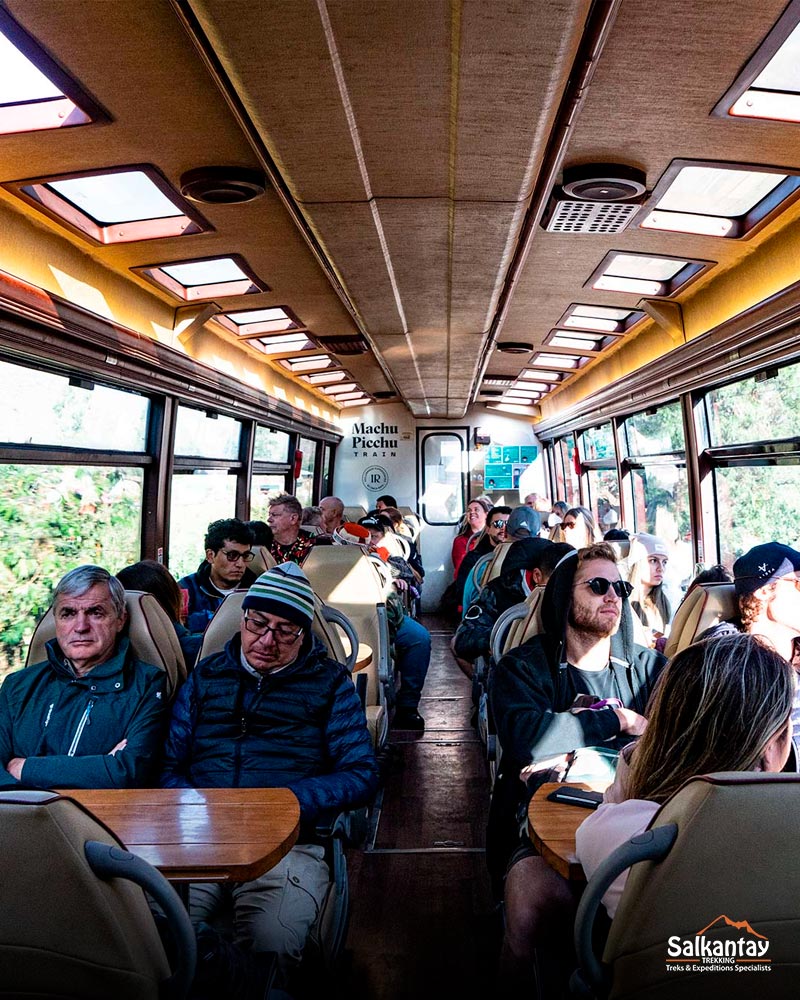
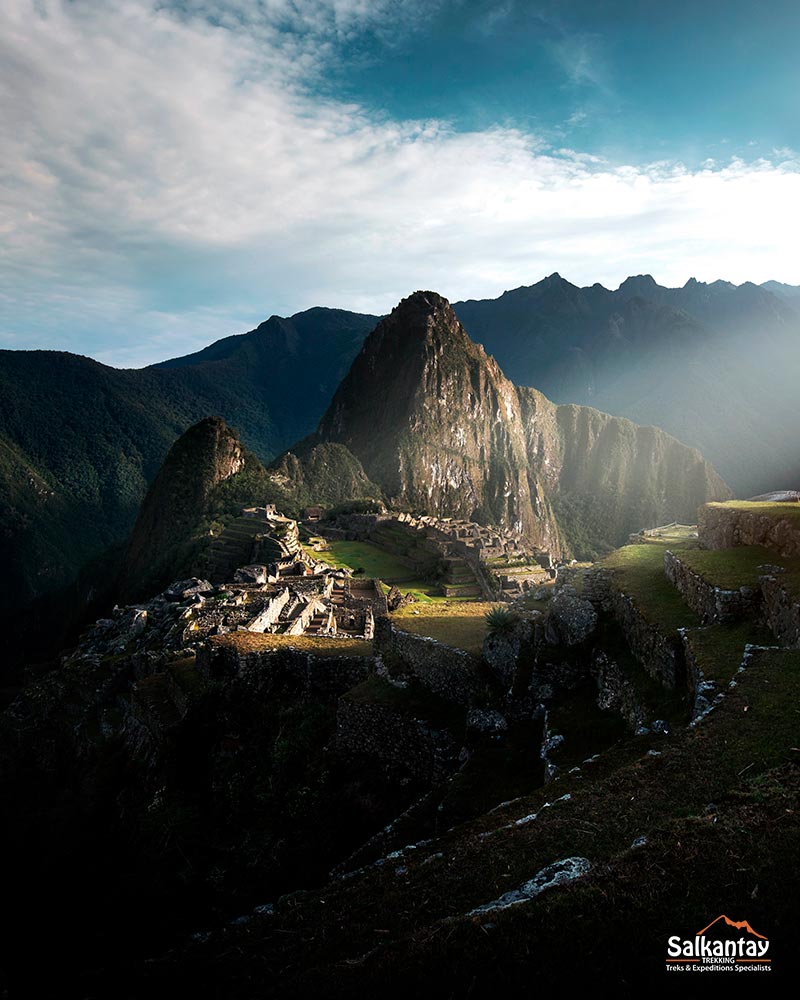
2. Colca Canyon
The Colca Canyon in the Arequipa region in southern Peru is one of the most stunning natural wonders and a must-see destination for nature lovers, culture enthusiasts, and adventure seekers. With an approximate length of 100 kilometers and over 3,400 meters, this canyon ranks among the deepest in the world, even more profound than the Grand Canyon in the United States. This magical environment combines breathtaking landscapes, unique biodiversity, and a rich cultural heritage that has endured for centuries.
How to Get to Colca Canyon
Accessing Colca Canyon is accessible from different points in Peru:
- From Arequipa: A 3-4 hour journey by bus or private car.
- From Puno (Lake Titicaca): A 5-6 hour bus ride.
- From Lima or Cusco: You can fly to Arequipa and continue by land.
Best Time to Visit
The dry season, from May to November, is ideal for exploring the Colca Canyon. During this period, the days are sunny, the nights are excellent, and the conditions are perfect for outdoor activities. However, the rainy season, from December to March, while less crowded, offers a greener, more lush landscape.
Highlights
Geographical and Historical Context
The Colca Canyon is more than just a geographical feature; it is a testament to the power of nature and human interaction with the environment. Formed by millions of years of erosion from the Colca River, its landscape features dizzying cliffs, ancient agricultural terraces, and majestic Andean peaks exceeding 6,000 meters in altitude. These terraces, built by the Collagua and Cabana cultures, are still in use today and reflect the agricultural ingenuity of their ancient inhabitants.
Living Culture and Traditions
The Colca Valley is a natural spectacle and a vibrant cultural hub. Local communities, descendants of the Collagua and Cabana peoples, preserve their traditions through colorful clothing, music, and festivals. One of the most emblematic events is the Festival of the Cross of the Condor, which celebrates the connection between nature and Andean spirituality. Visitors can also enjoy local crafts such as pottery and textiles and sample traditional dishes like shrimp chupe and alpaca meat, enriching the cultural experience.
Natural Beauty and Biodiversity
The Colca Canyon is a sanctuary of biodiversity. The landscape is home to resilient cacti, delicate orchids, and various Andean wildlife, including vicuñas, alpacas, and the majestic Andean condor. With a wingspan of up to 3.2 meters, this iconic bird symbolizes the connection between the Andes and the sky. The best viewpoints from which to admire its flight are at Cruz del Condor and Tapay, where these birds appear to float over the abyss, offering an unforgettable spectacle.
Activities for Visitors The Colca Canyon offers activities for all tastes. Every experience connects visitors with the place’s grandeur, from challenging hikes to spectacular viewpoints. Notable viewpoints include:
- Cruz del Cóndor: Ideal for observing condors in flight and enjoying panoramic canyon views.
- Antahuilque: Offers a unique view of pre-Inca terraces still in use.
- Achachiua and San Miguel: Perfect for appreciating the depth and majesty of the canyon from different perspectives.
Additionally, visitors should take advantage of the opportunity to relax in nearby hot springs, explore hidden oases, and enjoy landscapes that seem straight out of a dream.
Unforgettable Experience
Visiting the Colca Canyon is like stepping into a world where nature and culture converge in perfect harmony. From its epic landscapes to its rich cultural heritage, this destination promises a transformative experience. Whether you prefer hiking its trails, marveling at the condors’ flight, or simply soaking in the area’s serenity, the Colca Canyon will leave an indelible mark on your heart.
Are you ready to explore one of the most impressive natural wonders in the world? The Colca Canyon awaits you with open arms!

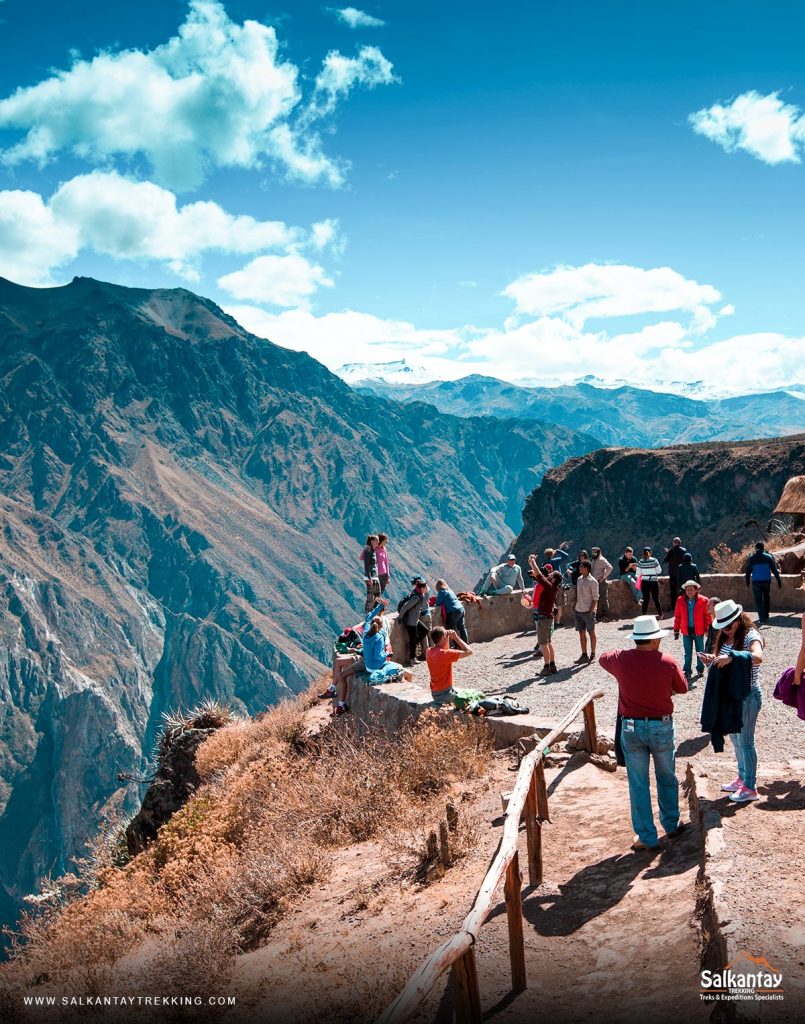
3. Nazca Lines
The Nazca Lines are one of humanity’s most fascinating archaeological wonders. These geoglyphs in the arid Nazca desert in southern Peru are colossal drawings on the ground that depict figures of animals, humans, and geometric shapes. The enigmatic Nazca culture created them between 500 BC and 500 AD, and their purpose remains a mystery. Declared a UNESCO World Heritage Site, these lines reflect incredible technical and artistic skill and a profound spiritual and astronomical connection to the environment.
Location and How to Get There
Location The Nazca Lines are located in the Ica region, specifically in the Jumana Pampas desert, between the cities of Nazca and Palpa, south of Lima.
Transportation Options
- From Lima:
- By bus: Approximately a 4-hour journey to Ica, followed by another 2 hours to Nazca.
- By car: A journey of about six hours along the Pan-American South Highway.
- From Arequipa or Cusco:
- Long-distance buses connect these cities to Nazca.
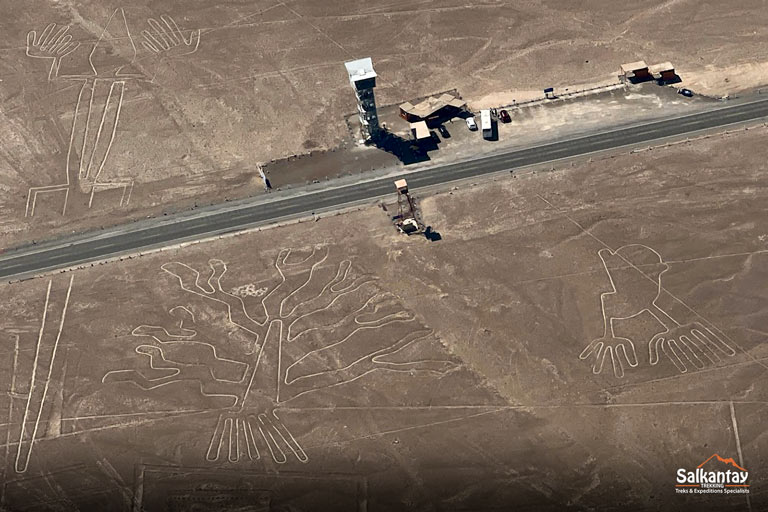
Best Time to Visit
The region’s desert climate makes the Nazca Lines accessible year-round. However, the best time is between May and November, when the dry season offers clear skies, perfect for aerial tours. Although rain is rare in the summer (December to March), it may hinder some road trips.
Highlights
Unique Features
The Nazca Lines span over 800 figures, including depictions of animals such as the hummingbird, monkey, spider, and pelican, intricate geometric designs, and human figures. These masterpieces reach massive sizes, with some figures over 300 meters in length. Surprisingly, these lines have endured for centuries, thanks to the dry climate and the geological conditions of the desert, which protect them from erosion and rainfall.
Mysteries and Legends
Over the years, the Nazca Lines have generated numerous theories about their creation and purpose. Some studies suggest that these figures served as astronomical calendars, while others believe they had ritual significance related to water and fertility. However, one of the most popular, albeit controversial, theories is that they were created with the help of extraterrestrial beings, a hypothesis promoted by Swiss writer Erich von Däniken.
Activities for Visitors
- Aerial tour by plane: The best way to appreciate the scale and detail of the lines is from the air—flights typically last 30 to 40 minutes.
- Ground-level viewpoints: If you prefer a closer perspective, there are observation towers and elevated points from which you can admire the figures.
- Exploring nearby sites: Visit the Cahuachi archaeological complex, a set of truncated adobe pyramids, or the Cantalloc Aqueducts, a hydraulic engineering feat created by the Nazca.
An Experience to Remember
Discovering the Nazca Lines is like delving into an ancient mystery. Whether admiring its stunning figures from a plane or exploring the surroundings, this experience uniquely combines history, nature, and culture. Despite the enigmas surrounding its purpose, these lines amaze travelers worldwide, offering a glimpse into the ancient Nazca culture’s profound astronomical and artistic knowledge.
Take the chance to witness one of the greatest mysteries of the ancient world. The Nazca Lines are waiting for you!
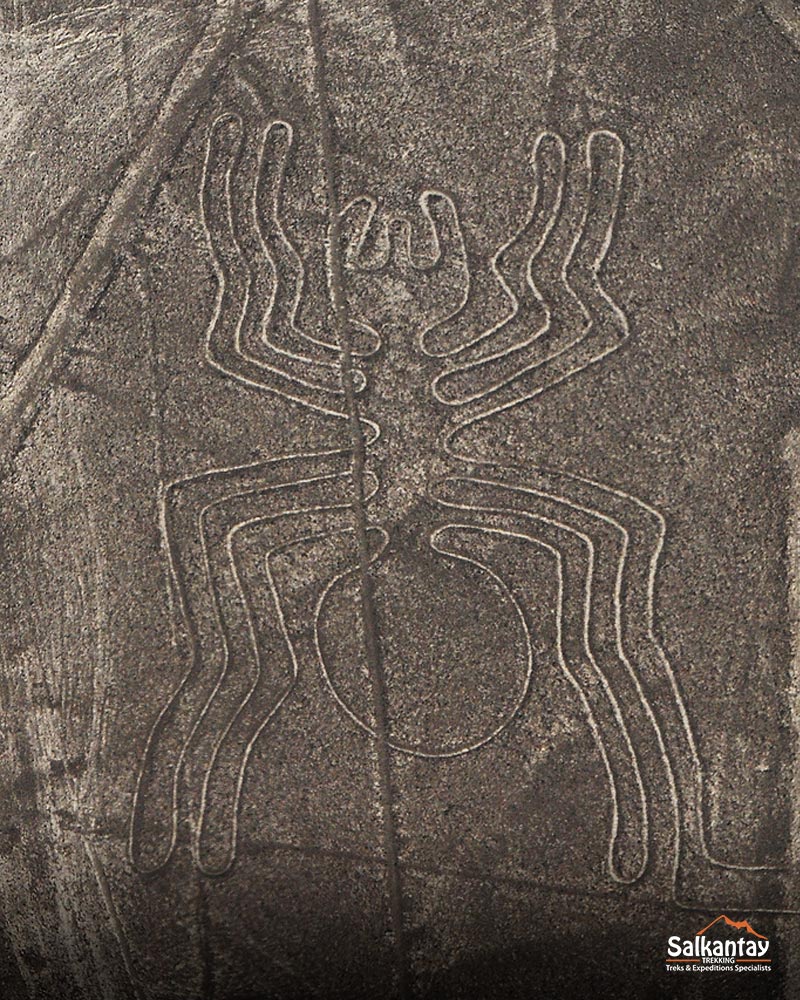
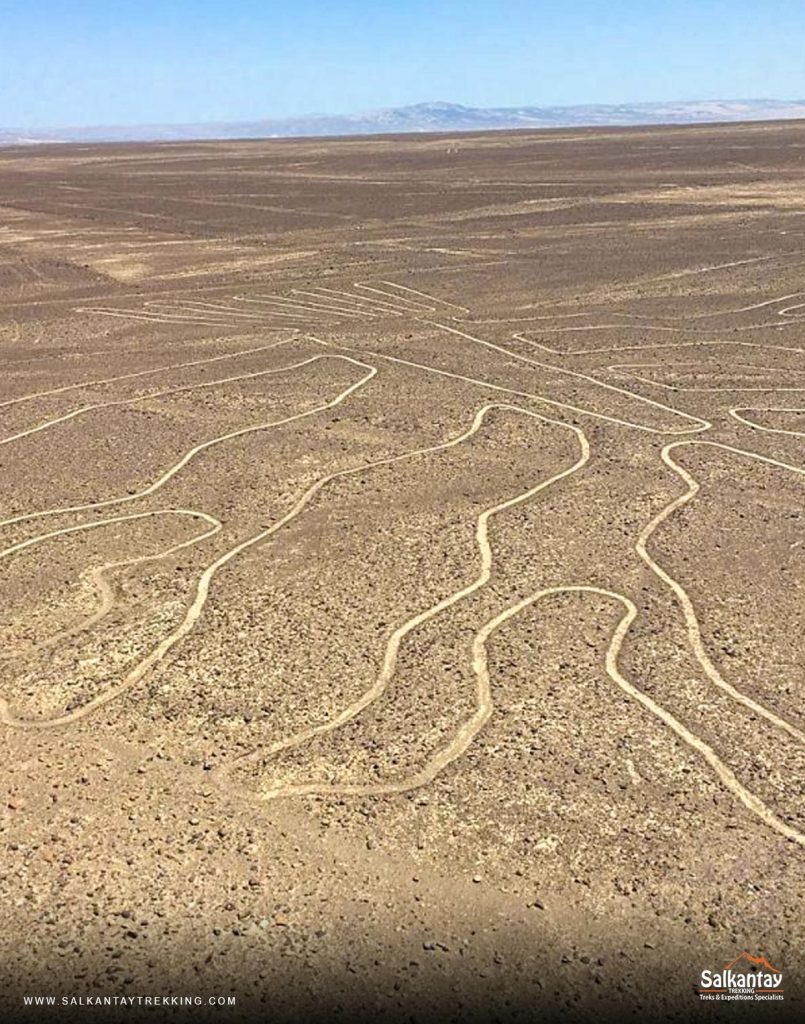
4. Chan Chan
Chan Chan, located on the northern coast of Peru, is the largest pre-Columbian adobe city in the world. This impressive archaeological complex was the capital of the Chimú Kingdom, a civilization that dominated much of the Peruvian coastline from the 9th century until its conquest by the Incas in 1470. Covering an area of 20 square kilometers and housing more than 60,000 inhabitants, Chan Chan stands as a unique testament to the architectural and cultural sophistication of the Chimú. Declared a UNESCO World Heritage Site in 1986, this city symbolizes the ancestral legacy of Peru and is an essential destination for history and archaeology enthusiasts.
Location and How to Get There
Location
Chan Chan is just 5 km from Trujillo, in the La Libertad region in northern Peru. Its proximity to the city makes it easily accessible for travelers.
Transportation Options
- From Lima:
- By bus: A 10 to 12-hour journey with companies like Cruz del Sur or Oltursa (around 75 soles).
- By plane: 1-hour flights to Trujillo are available from Jorge Chávez Airport.
- From Trujillo:
- Local bus to Huanchaco: An economical route (1.5 soles) that stops at Chan Chan.
- Taxi: Approximately 10-15 soles, ideal for more comfort.
Best Time to Visit
During the dry season, the best time to visit Chan Chan is between May and October. This period ensures clear skies and pleasant temperatures, perfect for exploring the ruins and surrounding areas.
Highlights
Unique Features
Chan Chan is known for its imposing citadels and palaces, surrounded by walls up to 10 meters high, built to withstand earthquakes and harsh weather conditions. These structures served multifunctional purposes: royal residences, storage spaces, temples, and mausoleums. The walls, decorated with intricate reliefs, display motifs of sea animals, geometric figures, and everyday scenes, reflecting the Chimú’s connection to the ocean and their natural environment. One of the most emblematic areas is the Tschudi Palace, the best preserved and open to the public. This site offers a detailed view of the political and ceremonial life of the Chimú, with spaces designed to maximize ventilation and protect from the desert winds.
Mysteries and Legends
The death of a king in Chan Chan marked the beginning of striking rituals: his first wife was sacrificed as part of a complex ritual, while the rest of his wives were buried with him in his palace, which became a mausoleum. In addition, child and animal sacrifices were made in honor of the lunar deity, reinforcing the city’s spiritual significance.
Activities for Visitors
- Tour of the Tschudi Palace: Explore the only palace open to the public, featuring impressive murals and ceremonial courtyards.
- Guided Tours: Learn about the history of Chan Chan with an expert guide who brings the ruins to life.
- Chan Chan Site Museum: Discover more about the Chimú culture through artifacts, reconstructions, and interactive exhibits.
- Nearby Archaeological Attractions: The entrance ticket also includes access to the Temple of the Sun and Moon, a marvel of the nearby Moche civilization.
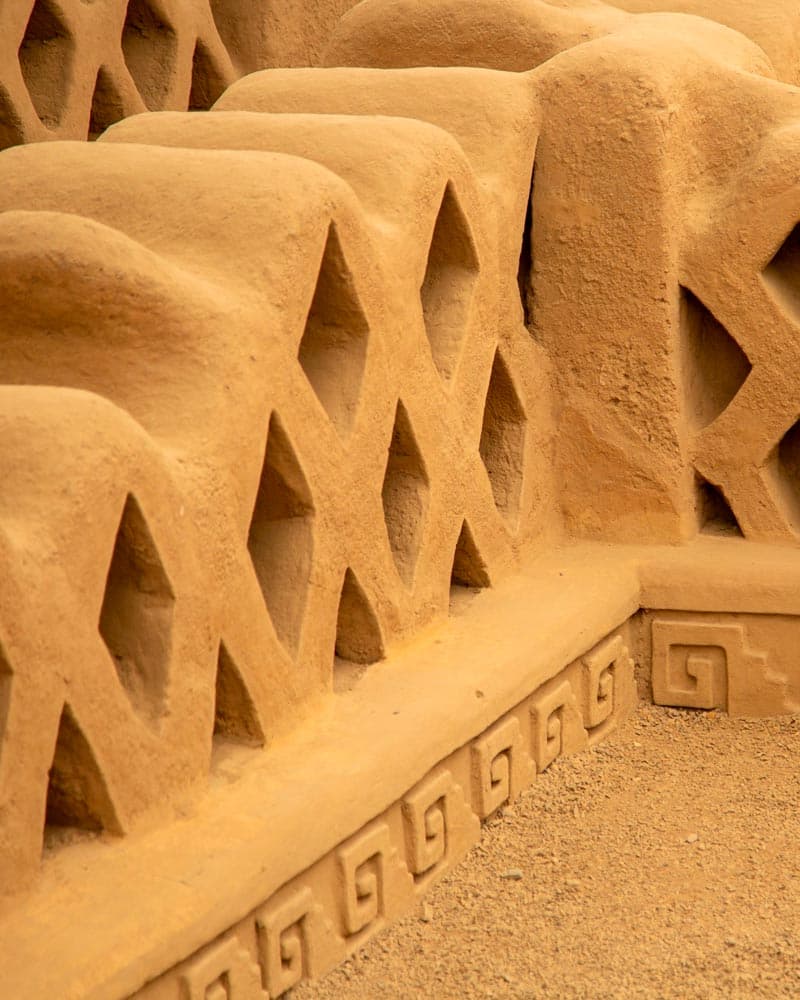
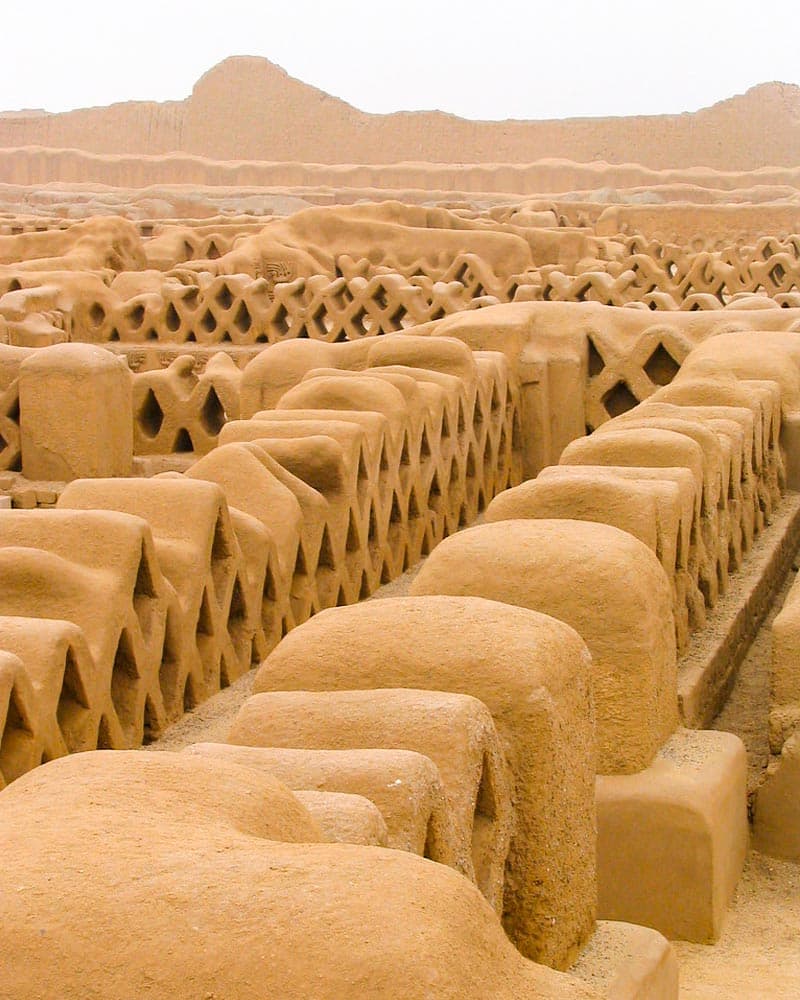
Costs
- Entrance Fee: Admission to the archaeological complex costs ten soles. To make the most of your visit, it is highly recommended that you hire a guide (starting at 40 soles).
- What to Bring: Light clothing, a hat, sunscreen, water, and comfortable shoes for walking in the desert.
- Combine Your Visit: Include other local attractions like Huanchaco, famous for its caballitos de totora (reed boats), or the Túcume pyramids, another fascinating pre-Columbian site nearby.
Chan Chan is more than just an archaeological site; it’s a journey into the heart of a civilization that left an indelible mark on Peru’s history. Its monumental architecture, mysterious legends, and rich cultural heritage make this site a must-see for anyone seeking to understand the splendor of pre-Inca cultures. Imagine immersing yourself in this adobe universe of mystery, where every corner tells a thousand-year-old story.
Plan your adventure and discover the magic of Chan Chan!
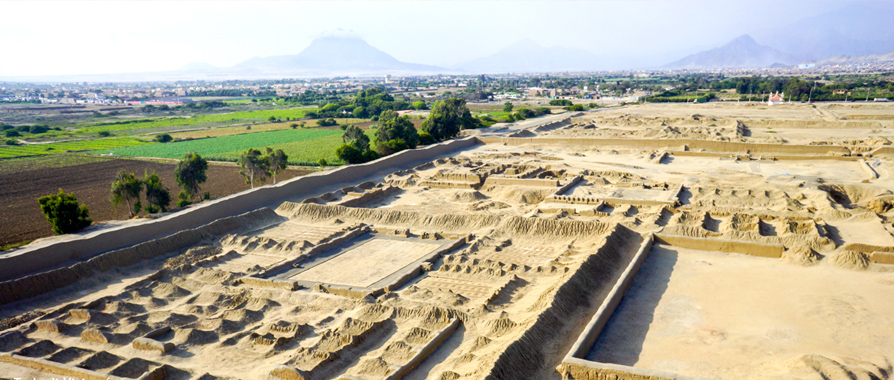
5. Caral
The Sacred City of Caral, also known as the cradle of civilization in the Americas, is the oldest urban settlement on the continent. This iconic archaeological site is located in the Supe Valley, Barranca Province, about 200 kilometers north of Lima. Built between 3000 and 1900 BCE, Caral was the epicenter of the Caral or Norte Chico civilization, one of the oldest in the world, alongside those of Mesopotamia, Egypt, India, and China. The site reflects the dawn of urban life and the development of an organized, peaceful, and profoundly spiritual society that lived in harmony with nature.
Declared a UNESCO World Heritage Site in 2009, Caral stands out for its monumental architecture and influence on other regions’ cultural and economic development in ancient Peru.
Location and How to Get There
Caral is located in the Supe District, Barranca Province, Lima Region. Getting there is easy:
- From Lima: Take a bus to Barranca. Tickets cost 15 to 30 soles, and the trip takes about 3 to 4 hours.
- From Barranca: Head to kilometer 187 of the Pan-American Highway North. There, you can take a colectivo (4 to 6 soles) or a taxi (around 40 soles) to the pedestrian entrance of Caral.
- Organized Tours: Another option is to book a tour from Lima that includes transportation, a guide, and entry to the site.
Best Time to Visit
Caral enjoys warm, dry weather year-round, with average temperatures between 20°C and 28°C. However, visiting between April and December is recommended when the weather is most pleasant.
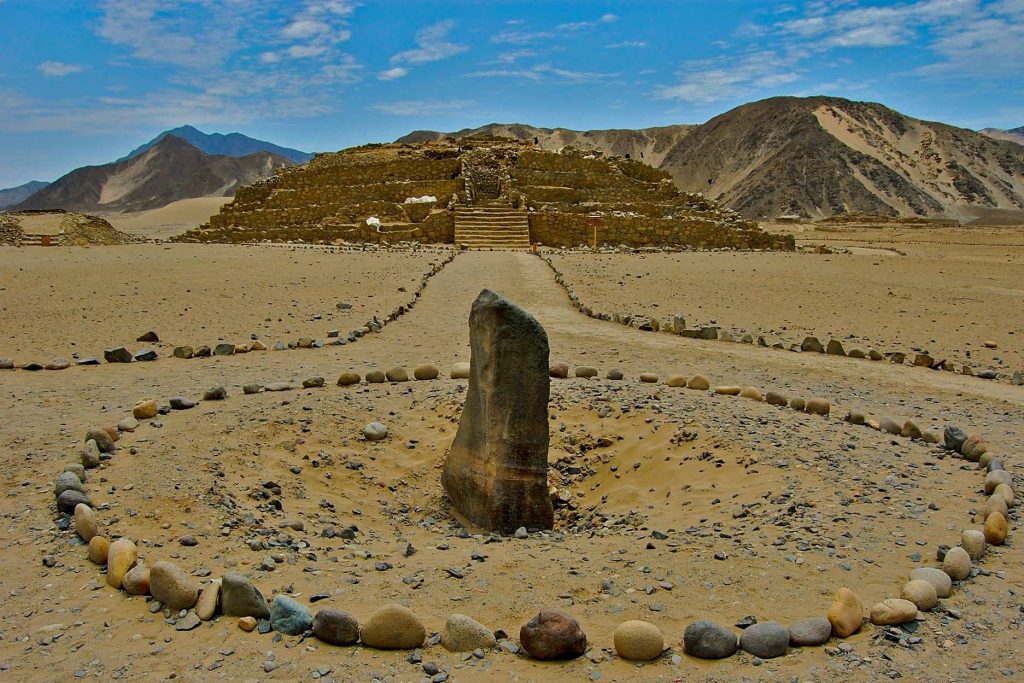
Monumental Architecture
The archaeological site spans 68 hectares and has a core area of 32 public and residential structures. Its most notable buildings include the pyramids, such as the Grand Pyramid, which rises over 29 meters high and has a 25-square-meter base. These constructions feature innovative techniques like shirts (bags of plant fiber filled with stones) used for seismic stability.
Other highlights include:
- Sunken circular plazas.
- Spaces for social and ritual interactions.
- Walls adorned with colored clay designed to withstand earthquakes.
Cultural and Social Significance
Caral was a model of social and economic organization. Its inhabitants established peaceful trade networks with coastal, highland, and jungle communities, exchanging goods like fish, cotton, and wood. Remarkably, no weapons or evidence of warfare have been found, indicating a society oriented toward peace and cooperation.
Discoveries of musical instruments decorated with bird and snake motifs reflect a culture rich in artistic and religious expression.
Mysteries and Discoveries
Archaeological research led by Ruth Shady since 1994 has identified 25 settlements linked to the Caral civilization in the Supe and Huaura Valleys. Sites like Áspero and Vichama reveal insights into daily life and religious practices.
Caral shows no signs of armies or warfare, standing out as a society prioritizing religion, trade, and harmonious living.
Activities for Visitors
Guided Tours: Visits must be conducted with local guides who explain the site’s history, architecture, and symbolism.
Cycling: Caral is also a destination for sports enthusiasts. The 23-kilometer Ruta de las Chacras offers stunning landscapes leading to the ruins.
Photography and Exploration: The plazas, pyramids, and valley views offer perfect backdrops to capture the site’s grandeur.
Caral is more than an archaeological site; it is a living testament to the origins of civilization in the Americas. Exploring this fascinating destination takes you deep into the continent’s oldest history and reveals the roots of the social and cultural organization that shaped Peru’s development. It is a must-visit destination!
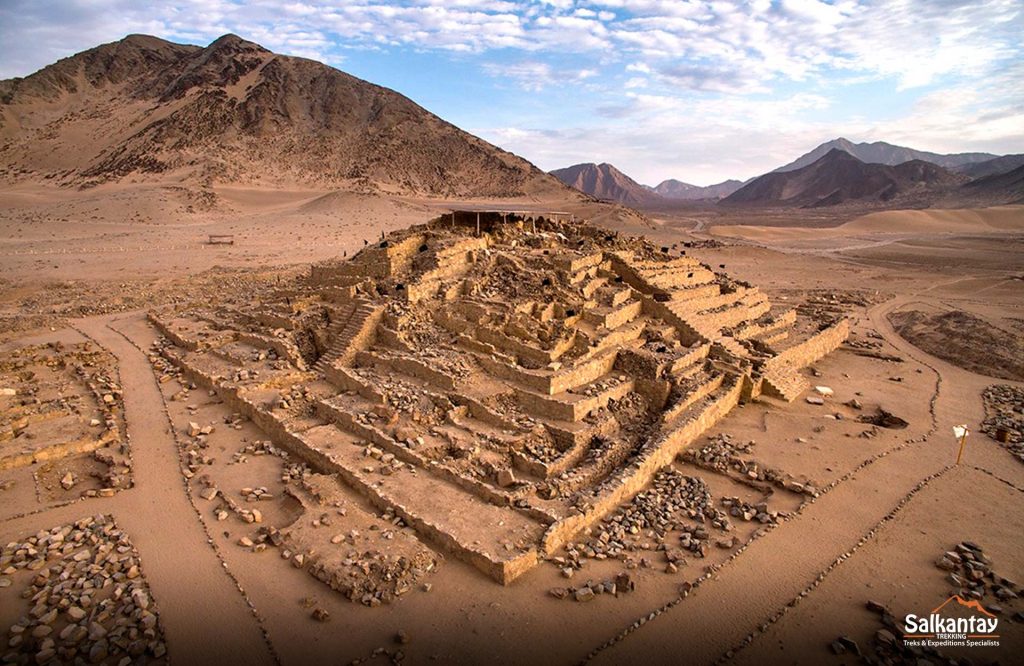
6. Kuelap
Kuélap, known as the “Machu Picchu of the North,” is an imposing fortified city built by the Chachapoyas, a pre-Inca culture that inhabited the region between 900 and 1400 AD. Located over 3,000 meters above sea level in the northern Amazonian region of Peru, this fortress safeguards an invaluable historical legacy. Spanning an extensive area of 626 hectares, it contains more than 420 circular structures, including civil, religious, and military buildings. Kuélap was a political and cultural center and a testament to the advanced social organization of the Chachapoyas, known as the “Warriors of the Clouds.”
With its strategic location atop a mountain, Kuélap offers breathtaking views and a mystical atmosphere, making it a must-visit destination for history, nature, and adventure enthusiasts.
Location and How to Get There
Kuélap is located in the Luya province of the Amazonas region, 38 km from Chachapoyas. Here’s how to get there:
- From Chachapoyas to Nuevo Tingo: Take local transportation or a taxi to the cable car terminal in Nuevo Tingo.
- Cable Car to Kuélap: Purchase your ticket at the Nuevo Tingo station (approximately S/ 21 round trip). This 20-minute ride takes you to the tourist area known as La Malca.
- Final Walk: From La Malca, take a 30-minute walk (1 km) to the fortress’s main entrance.
From Lima:
- Fly to Chiclayo, then take a 9-hour bus ride to Chachapoyas.
- Alternatively, take a direct bus from Lima to Chachapoyas (22 hours).
Best Time to Visit Kuélap
From April to November, the dry season is the ideal time to visit the fortress, as there is minimal rain and the weather is more pleasant. During these months, the trails are in better condition, and the landscapes are stunning. Additionally, local festivities in June offer visitors the chance to immerse themselves in the region’s culture.
Highlights
Monumental Architecture
The fortress is surrounded by walls up to 20 meters high, built to protect its inhabitants from potential attacks. Among its main attractions is the Gran Plataforma (Great Platform), a colossal structure that served as a ceremonial and administrative center. The circular dwellings, many of which still retain decorative details like rhomboid and zigzag friezes, are particularly noteworthy.
Mysteries and Legends
Kuélap is a testament to the advanced engineering of the Chachapoyas and a place full of enigmas. It is said to have been used for spiritual rituals, and its elevated position connected its people with the world of the gods. Archaeologists continue to explore potential tombs and hidden chambers, seeking to understand more about this fascinating civilization.
Activities for Visitors
In addition to exploring the ruins, visitors can enjoy walking along trails surrounded by stunning natural landscapes, exploring replicas of Chachapoyan houses, and marveling at the panoramic views from a lookout point that offers a privileged perspective of the region. For the more adventurous, the cable car ride provides a unique experience combining adrenaline with breathtaking scenery.
Practical Tips for Your Visit
- Hours: The fortress is open Tuesday to Sunday, from 9:00 a.m. to 2:50 p.m. Maintenance is conducted on Mondays.
- Tickets:
- CAMK Ticket: This ticket is free and allows access to the surrounding areas of Kuélap, such as the tourist area and house replicas.
- CAMK + LLAQTA Ticket: Grants full access to the internal circuit of the fortress. Tickets can be purchased online at Tuboleto—culture. Pe.
- Gear: Wear light clothing, comfortable footwear, sunscreen, a windbreaker, and bring water.
- Punctuality: Groups are limited to 12 people, and arriving on time at the designated control point on your ticket is essential.
Kuélap: A Unique Experience
Visiting Kuélap is much more than exploring an archaeological site; it’s delving into the rich history of the Chachapoyas and enjoying an unparalleled natural setting. From its majestic walls to the stories its stones tell, this fortress invites you to travel back in time and discover the secrets of one of South America’s most fascinating cultures.
Ready for this adventure? Kuélap awaits with open arms.
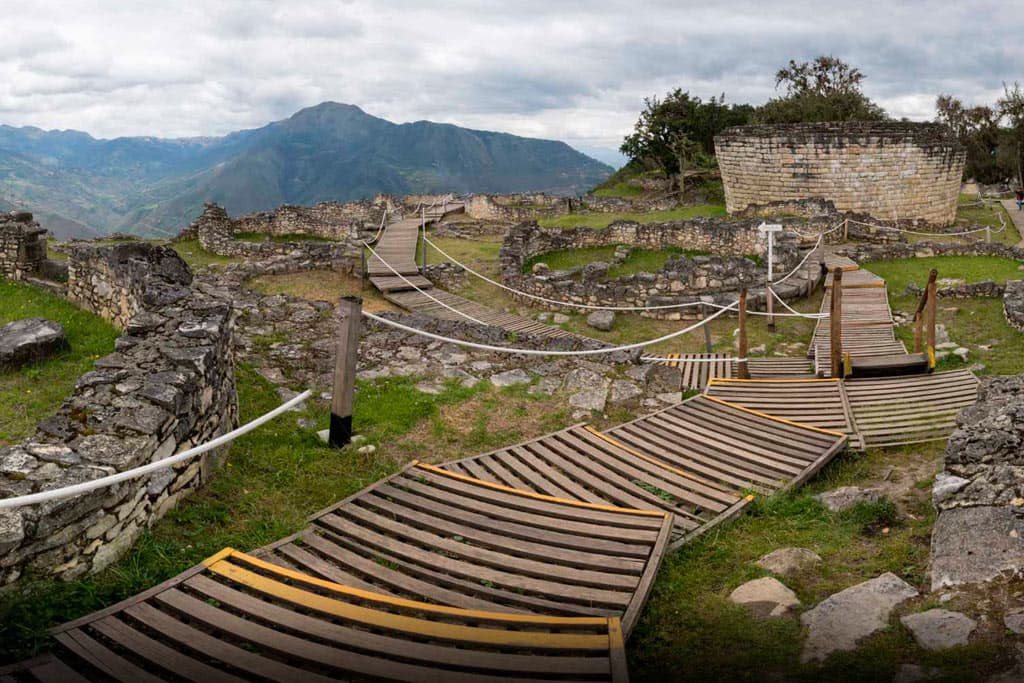
7. Huaca Pucllana
Located in the heart of Miraflores, one of Lima’s most vibrant districts, Huaca Pucllana is a fascinating testament to the Lima civilization. This pre-Inca culture left a deep mark on Peru’s history. Once forgotten and at risk of destruction, this archaeological site has emerged as one of the main tourist attractions in the Peruvian capital, highlighting its historical and cultural importance.
Huaca Pucllana is an adobe pyramid and urban complex that spanned six hectares and extended much further in its heyday. Its strategic location next to the Rímac River allowed the ancient inhabitants to control water routes and irrigation channels, critical elements for their civilization’s development.
Location and How to Get There
Huaca Pucllana is located in the Miraflores district in the heart of Lima, making it easily accessible from nearly any part of the city. Surrounded by modern city streets, the site has retained its essence thanks to its large size and conservation efforts.
You can reach the site by public transport, taxi, or on foot from central Miraflores, making it a convenient destination for tourists and locals.
Best Time to Visit
While Huaca Pucllana can be visited year-round, Lima’s mild climate makes the dry season from December to April the most pleasant time to explore the site.
Highlights
Unique Architecture
The most striking feature of Huaca Pucllana is its imposing stepped pyramid, rising up to eight meters high. Constructed with thousands of vertically placed adobe bricks using the “bookshelf technique,” the structure was designed to withstand the frequent earthquakes in the region. The pyramid’s walls, coated with yellow-painted clay—a sacred color for its builders—showcase the sophistication and knowledge of ancient Limeños.
Beyond the pyramid, the site includes other ceremonial buildings and residential areas built on fill layers, revealing how the city evolved.
Rituals and Ceremonial Life
Huaca Pucllana was more than an urban center; it was a place of deep religious and ceremonial significance. Religious rituals were performed here, including human sacrifices—especially of young women—and ceremonial feasts where sharks and other seafood played a central role. These rituals aimed to thank the deities and ensure the community’s prosperity.
Three Occupation Periods
Excavations at Huaca Pucllana have uncovered three distinct periods of occupation: from the Lima culture to the influence of the Huari culture and the presence of the Ychsma. Each phase left its mark on the site, making it a unique place to understand the region’s evolution.
Activities for Visitors
- Today, Huaca Pucllana is a space for learning and exploration. Guided tours allow visitors to admire the main pyramid and nearby structures while delving into the history and secrets of the Lima culture. The native flora and fauna park offers a glimpse of the plants and animals that were part of the ancient Limeños’ natural environment.
- The exhibition hall, inaugurated in 1984, showcases artifacts and archaeological findings that provide deeper insights into the daily life, rituals, and architecture of the valley’s ancient inhabitants.
Visiting Huaca Pucllana is like traveling back in time to pre-Columbian Lima, discovering the grandeur of the Lima culture. With its impressive pyramid, unique architecture, and fascinating history, Huaca Pucllana offers a unique experience that connects visitors to a vital part of Peruvian heritage. Despite being surrounded by the hustle and bustle of the modern city, it remains an oasis of history and culture, waiting for you to uncover its secrets.
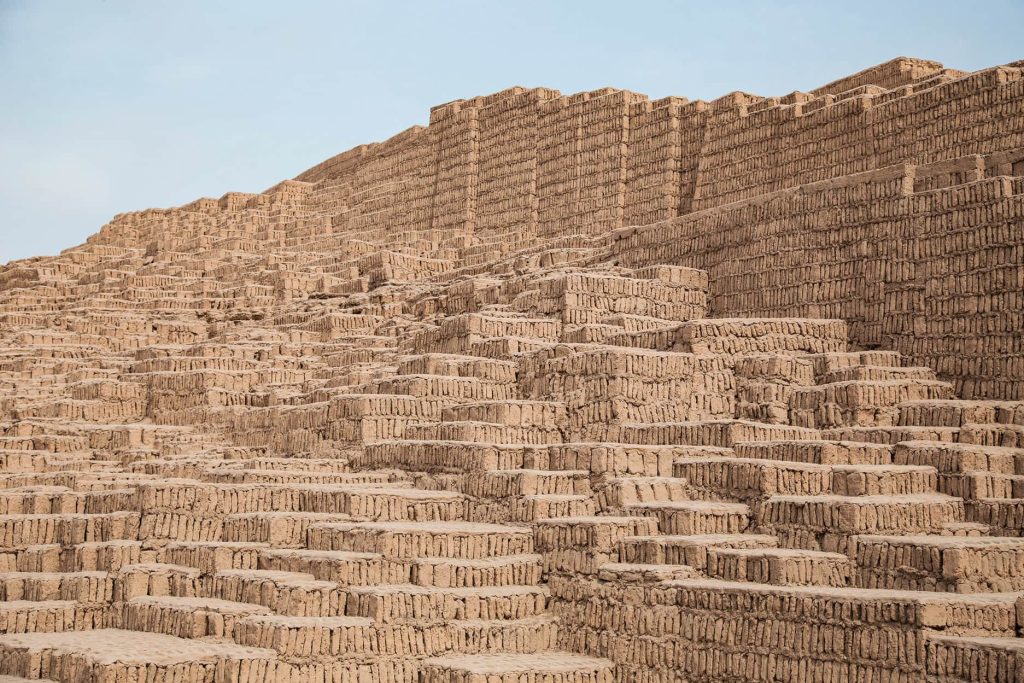
8. Islas Ballestas
The Islas Ballestas, known as the “Peru’s Little Galápagos,” are a rocky archipelago off the coast of Paracas in the Ica region. These islands, formed by volcanic geological processes and shaped by marine erosion over thousands of years, boast breathtaking landscapes and rich biodiversity. They are a haven where marine life and birds thrive, captivating travelers worldwide.
Why Are the Islas Ballestas Important?
The Islas Ballestas are one of the most iconic destinations for nature enthusiasts due to their incredible diversity of wildlife. They are home to various species, including sea lions, Humboldt penguins, and migratory and resident birds such as pelicans, cormorants, and gulls. The islands also serve as a marine sanctuary and conservation hub, enhancing their ecological importance.
Location and How to Get There
From Lima
The Islas Ballestas are near Paracas, a coastal village in the Ica region, approximately four hours south of Lima. Visitors must take a boat from the Paracas harbor to reach the islands, as landing is prohibited to preserve the ecosystem.
Transport Options from Lima
- By bus: Major companies like Cruz del Sur and Oltursa offer direct routes to Paracas, which take 3–4 hours to travel. Ticket prices range from 40 to 70 soles, depending on the service type.
- By private or rented car: For more flexibility, you can rent a car or travel in a private vehicle. The trip takes about 3.5 hours, depending on traffic.
- By organized tour: Many tour operators in Lima offer packages that include transportation, a guide, and a boat tour to the Islas Ballestas, making it a convenient option.
Best Time to Visit
From April to October, the dry season is the best time to visit the Islas Ballestas. The weather is sunnier and less foggy during this period, making it ideal for wildlife viewing and photography. However, this is also the high tourist season, so early booking is recommended for tours and accommodations.
A Lasting Memory
Unique Geological Formations
One of the most fascinating aspects of the Islas Ballestas is their geography. Natural erosion has created striking cliffs and caves over thousands of years. The enigmatic “Candelabra” geoglyph, visible from the sea, combines natural beauty with history and mystery.
Abundant Wildlife
The islands’ main attraction is undoubtedly their marine life. During boat tours, visitors can see sea lions lounging on rocks or playing in the water and endangered Humboldt penguins gliding through the Pacific’s calm waters. With over 150 bird species, the islands are a paradise for bird watchers.
A Conservation Refuge
The Islas Ballestas are a protected natural reserve home to endangered species. Tours provide information about conservation efforts and the balance between marine and terrestrial ecosystems.
Visitor Activities
Boat Tours
The primary activity at the Islas Ballestas is the boat tour. Departing from Paracas harbor, these tours offer unforgettable experiences as you navigate the crystal-clear waters surrounding the archipelago.
Wildlife Observation
Marine life sightings are a highlight. You’ll encounter sea lions, Humboldt penguins, and numerous birds.
Paracas National Reserve
Consider pairing your visit with the nearby Paracas National Reserve. This protected area is known for its desert landscapes, pristine beaches, and birdwatching opportunities.
Nature Photography
The Islas Ballestas are a photographer’s paradise with dramatic marine landscapes and abundant wildlife.
The Ballestas Islands are a must-see destination for those seeking a unique experience in contact with nature. With its incredible biodiversity, breathtaking landscapes, and the opportunity to learn about marine ecosystem conservation, the Ballestas Islands offer an adventure combining natural beauty and environmental education. Whether you travel alone, as a couple, or with your family, this archipelago leaves an indelible impression on every visitor.
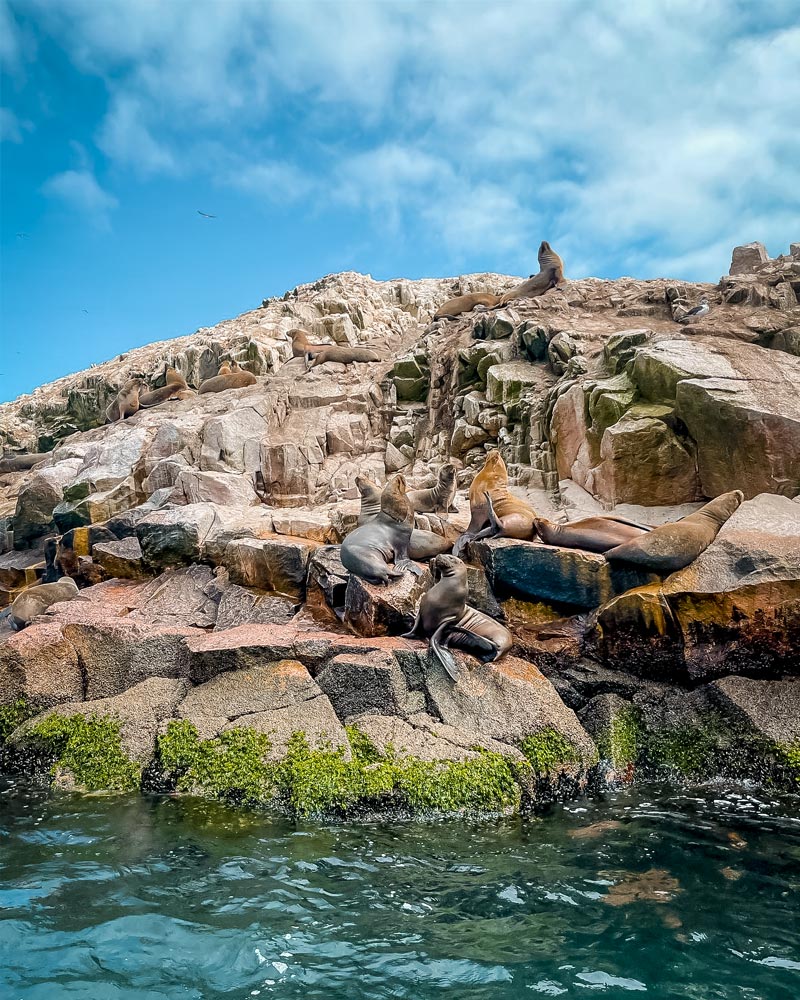
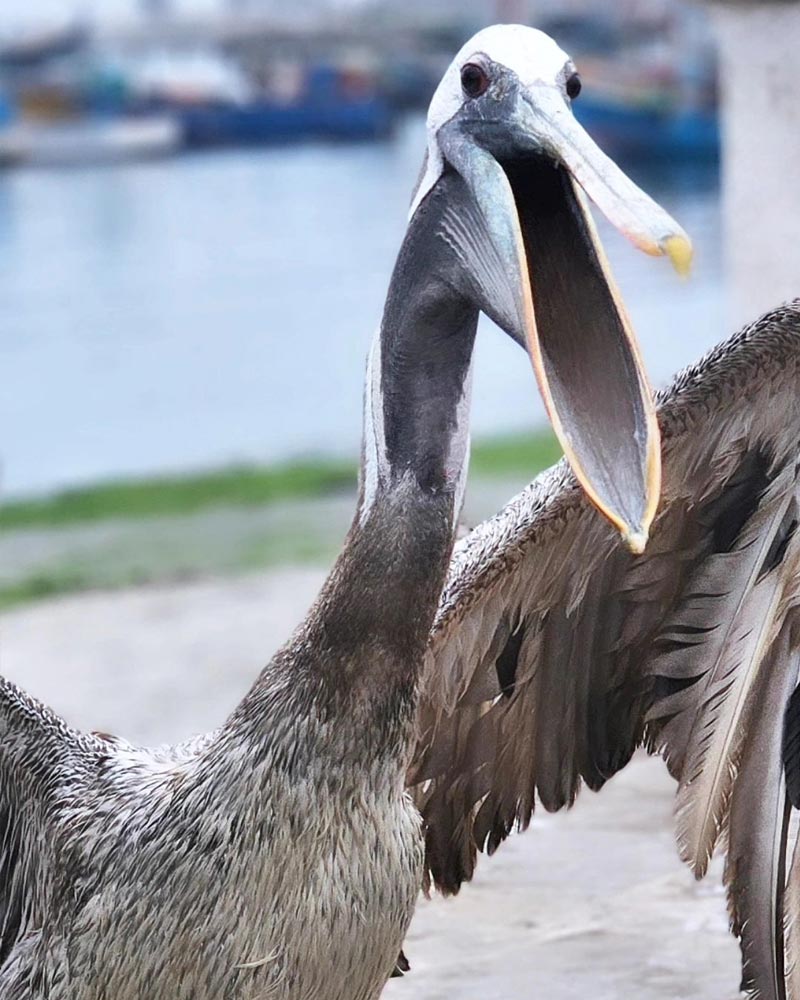
9. Lake Titicaca
Located at 3,812 meters above sea level, Lake Titicaca is the highest navigable lake in the world and the largest by volume in South America. This breathtaking body of water shared between Peru and Bolivia is renowned for its crystal-clear waters, stunning landscapes, and fascinating cultural life of the communities inhabiting its islands. It is an iconic destination for travelers eager to learn about the history and traditions of Andean cultures, such as the Uros and Taquileños, who have lived along its shores and floating islands for centuries.
Location and How to Get to Lake Titicaca
From Peru
Lake Titicaca is located in southern Peru, with Puno as its main gateway. Travelers can choose from various transportation options to reach Puno:
- By plane: Flights from Lima to Juliaca, about 45 minutes from Puno, are a fast and convenient option.
- By train: The famous luxury train, the Belmond Andean Explorer, connects Cusco to Puno and offers a spectacular panoramic travel experience.
- By bus: Several bus services link Lima to Puno, lasting approximately six hours.
Once in Puno, visitors can take boat tours to nearby islands, including the Uros Floating Islands, Taquile Island, and Amantaní Island.
From Bolivia
From La Paz, Bolivia, you can take a bus to Copacabana, a picturesque town on the shores of Lake Titicaca. The trip takes about 3 to 4 hours; tourists can take boats to Isla del Sol and other nearby islands.
Best Time to Visit Lake Titicaca
The ideal time to visit Lake Titicaca is during the dry season, between April and October. During this period, the weather is sunnier and more pleasant, making exploring the islands more accessible and engaging in outdoor activities more enjoyable. However, due to the lake’s altitude, nights can be freezing.
A Unique Experience
Uros Floating Islands
One of the most fascinating attractions of Lake Titicaca is the Uros Floating Islands. This unique community has built over 80 artificial islands using totora, an aquatic plant that grows in the lake. These islands, inhabited by Uros families, consist of homes, rafts, and other totora structures. Visitors can interact with residents who still use traditional totora boats to navigate the lake and learn about the history and customs of this ancient culture.
While tourism has changed the Uros’ lifestyle, many still practice their traditional way of life, while others have adopted more modern habits along the lake’s shores. This contrast between tradition and modernity offers a unique cultural experience.
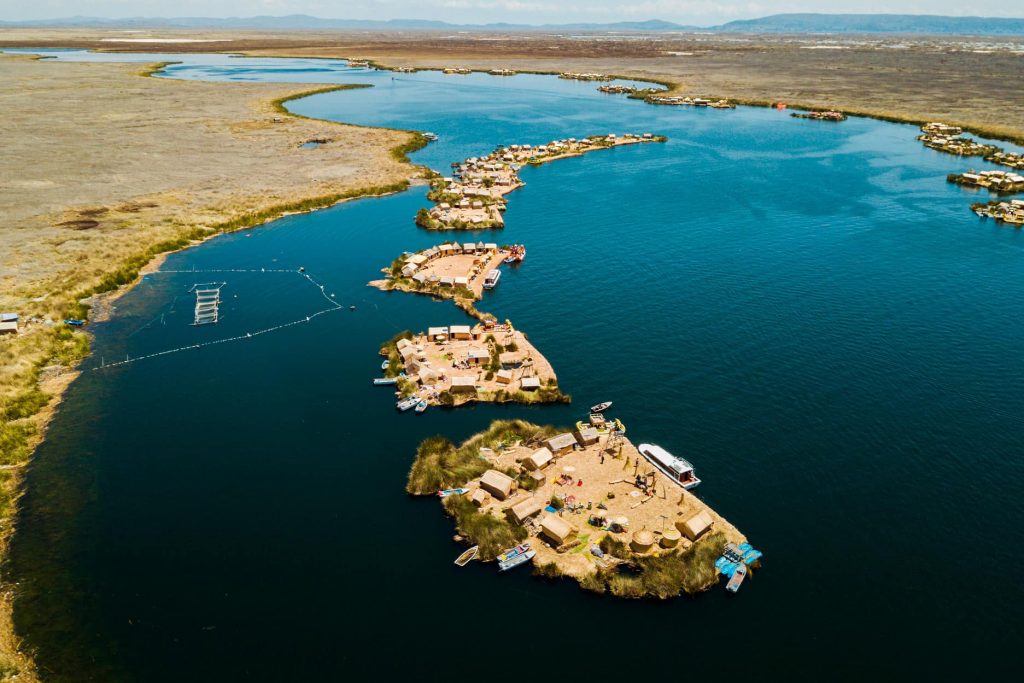
Taquile Island
Located 40 kilometers north of Puno, Taquile Island is famous for its Quechua-speaking community and strict traditions. The island’s inhabitants are known for their colorful clothing and exceptional weaving skills. Weaving is so integral to Taquile’s culture that men must demonstrate their weaving abilities, creating intricate items capable of holding water, before they can marry.
The island offers spectacular views of Lake Titicaca and is perfect for a peaceful hike through its streets and trails. Tourists can also stay overnight in local homes, an authentic experience that allows them to learn more about the island’s traditions and enjoy the locals’ hospitality.
Amantaní Island
Unlike Taquile, Amantaní Island has been less affected by tourism and retains an air of authenticity. Boats depart from Puno every morning for the 4-hour journey to the island. On Amantaní, visitors can experience local life in its purest form, as the island lacks electricity and its residents maintain many of their ancestral traditions.
The Pachatata and Pachamama trails offer stunning views of the lake and fascinating walks through ancient pre-Inca ruins. Staying with local families enriches the cultural experience, providing an authentic cultural exchange. For adventure-seekers, kayaking around the islands offers a closer and more intimate lake experience.
Isla del Sol (Bolivia)
Located on the Bolivian side of the lake, Isla del Sol is another must-visit destination for those exploring Lake Titicaca. According to local legends, this island holds significant historical and spiritual significance for the region’s indigenous peoples, as it is considered the sun’s birthplace. Visitors can explore ancient ruins of pre-Inca temples, enjoy stunning lake views, and learn about Andean traditions. Isla del Sol is also famous for its beautiful natural landscapes and tranquil atmosphere, ideal for those looking to escape city life.
Must-Do Activities
- Boat tours: Explore the floating and other lake islands on a guided boat tour.
- Hiking on the islands: Walk the trails for incredible views and an immersive experience of local traditions.
- Cultural interaction: Overnight stays in local homes provide a deeper connection with the lake’s communities and an authentic cultural experience.
- Wildlife watching: Observe various bird species and native flora around the lake and its islands.
Lake Titicaca offers more than breathtaking landscapes; it is filled with history, culture, and ancient traditions. Whether you explore its floating islands, learn about the people who live on its shores, or enjoy its natural beauty, Lake Titicaca promises an unforgettable experience. With its mix of tradition, mysticism, and nature, it is a destination every traveler should visit at least once in their lifetime.
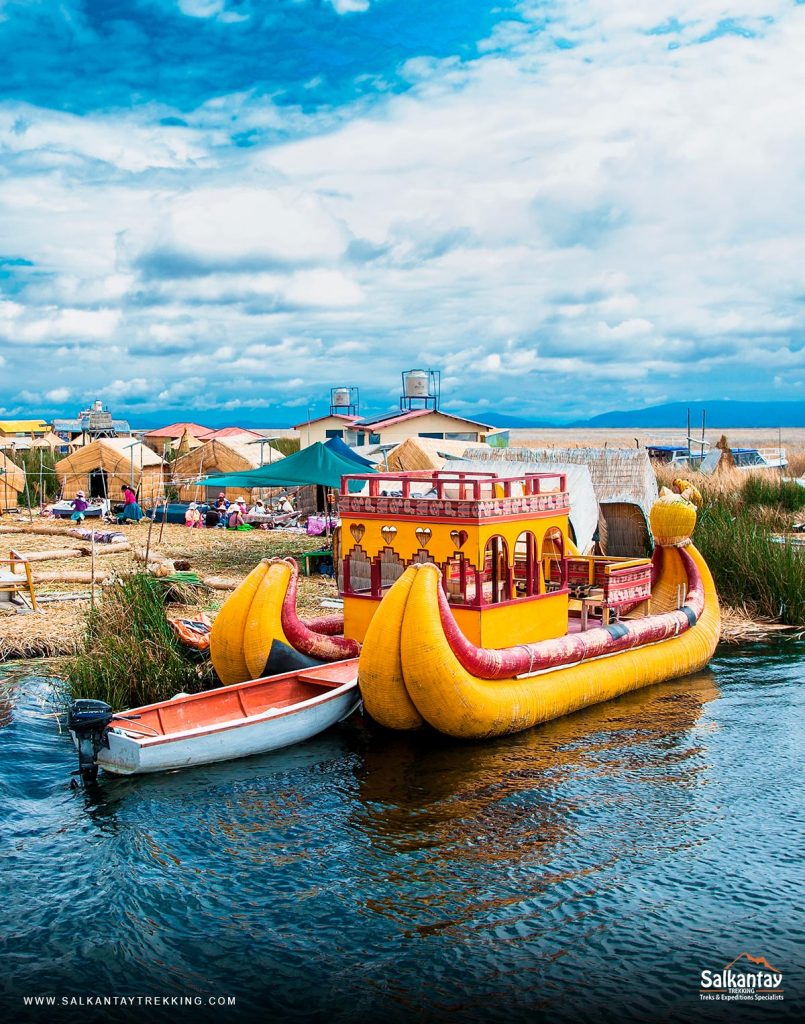
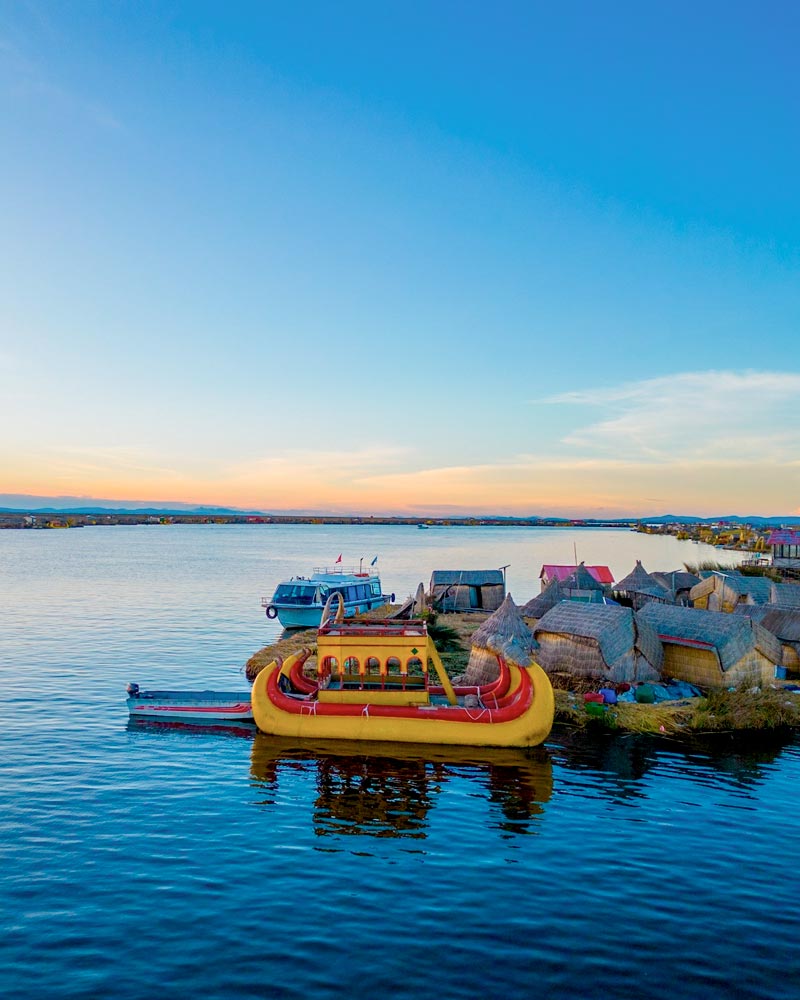
10. Combayo Windows
The Ventanillas de Combayo is an important archaeological site of the Cajamarca culture, located about 35 kilometers north of Cajamarca in northern Peru. This impressive pre-Inca cemetery is considered one of the oldest in the country, dating back more than 3,500 years. This ancient cemetery consists of niches and crypts carved directly into the cliffs of San Cristóbal Hill, creating a mystical ambiance in the natural landscape. These “windows” were believed to be used to bury the region’s inhabitants, who practiced funerary rituals unique to their culture. The site’s significance lies in its antiquity, unique architectural design, and the mysteries surrounding the customs of the Cajamarca people.
Location and How to Get There
Region and Nearest City:
The Ventanillas de Combayo are located near Cajamarca in northern Peru. For those interested in exploring the region, Cajamarca is an excellent starting point, and the route to Combayo is relatively accessible from the city.
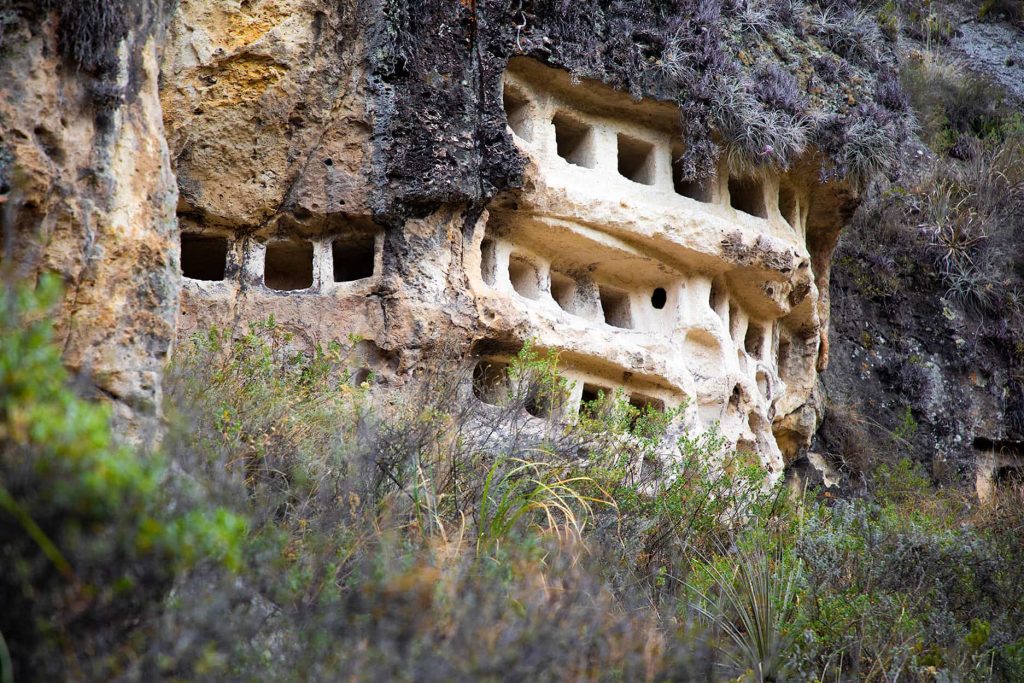
Transportation Options:
- By Public Transport: From downtown Cajamarca, you can take combis (minibusses) heading to Combayo. The site entrance takes about an hour and costs between 4 and 6 soles. Be sure to inform the driver that you will get off at the archaeological site entrance. From there, you’ll walk along a trail that leads directly to the mountain’s base.
- By Private Vehicle: From the El Quinde shopping plaza in Cajamarca, follow the road towards the airport, then take the route towards Otuzco and continue to Combayo. The journey is approximately 24 kilometers to the Ventanillas entrance. The road is partially paved but suitable for all types of vehicles.
- By Private Tour: For a more comfortable option, some travel agencies offer private tours to the Ventanillas de Combayo, although this route is not commonly included in standard tourist itineraries. Private taxis charge between 80 and 120 soles for round-trip service.
Best Time to Visit
Weather and Conditions:
The area has a temperate climate, but temperatures can vary significantly throughout the day due to its mountainous location. Daytime temperatures are usually pleasant, but nights can be cold. The best time to visit the Ventanillas de Combayo is during the dry season, from May to October when the weather is more stable and hiking conditions are ideal. Avoid the rainy months (November to April), as the trails can become slippery and challenging.
Highlights
Unique Features:
The Ventanillas de Combayo are famous for the niches carved into the high cliffs, resembling small windows that open into the abyss. These niches, arranged in multiple layers on the mountainside, were used as tombs, and some still contain bone fragments and remnants of the clay and stone walls that once sealed the crypts. This structure showcases the Cajamarca culture’s advanced stonework skills and remarkable organization, which created complex funerary sites and adapted perfectly to their natural surroundings.
Mysteries and Legends:
The Ventanillas de Combayo have inspired various local legends. The crypts are believed to hold the remains of great leaders and shamans of the Cajamarca culture. However, the exact reason these tombs were carved into the rocks remains a mystery. Additionally, the funerary practices of the Cajamarca people, including using cliff niches, suggest a deep connection with the mountains, which are considered sacred by many Andean cultures.
Activities for Visitors
Visitors to the Ventanillas de Combayo can enjoy various activities that immerse them in this unique site’s history and natural beauty.
- Hiking: Walk along the trails surrounding the mountain to get closer to the niches and observe the details of the stone constructions. Along the way, you’ll find ancient staircases, some of which are still used to access different levels of the windows.
- Guided Tours: Local guides offer informative tours about the area, the funerary customs of the Cajamarca culture, and the excavation process of the crypts.
- Relax by the Stream: A nearby stream with crystal-clear waters and rounded stones invites visitors to relax and enjoy nature.
- Explore the Village of Combayo: Visit the picturesque village, where you can find local restaurants and a traditional main square, ideal for experiencing the daily life of the region’s regions.
Special Events
If you visit the area during Cajamarca or the Feast of the Virgen del Rosario, you can experience local festivities, including music, dances, and vibrant celebrations of Cajamarca culture.
Recommendations
- Wear Appropriate Clothing: Comfortable hiking attire, such as long pants and long-sleeved shirts, is recommended as the trail to the Ventanillas may have thick vegetation. Ensure you wear sports shoes or hiking boots for comfort and safety.
- Start Early: To make the most of your day and avoid crowds, leave Cajamarca early. This also ensures that transportation is available for your return.
- Please stick to the Trails: Although the paths to the Ventanillas are accessible, it’s best to stay on marked trails, as the terrain can be slippery and dangerous.
The Ventanillas de Combayo is a must-visit destination for history, archaeology, and nature enthusiasts. This fascinating pre-Inca cemetery, with its niches carved into the mountains, offers a unique insight into the ancient funerary practices of the Cajamarca culture. As you explore the ruins, you’ll immerse yourself in the history, mysticism, and legends surrounding this mysterious site. Without a doubt, a visit to the Ventanillas de Combayo is an experience that connects you to the deep roots of Peruvian history.
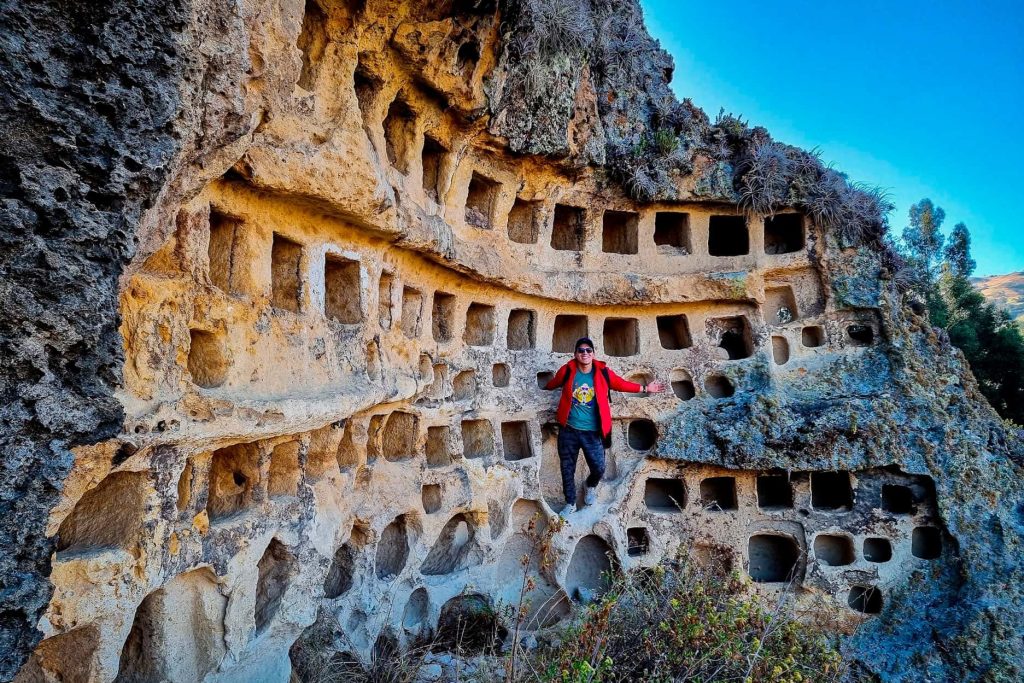
Peru has history, culture, and natural wonders that have left their mark over the centuries. From Machu Picchu to the mysterious Ventanillas de Combayo, each of the 10 historical sites we’ve explored offers a unique experience, capable of transporting us back to ancient times when civilizations like the Incas and Cajamarca left their legacy on the lands we now travel.
Each of these locations is a testament to the architectural and cultural grandeur of ancient cultures and a reminder of Peru’s deep connection to its past. These destinations are perfect for those seeking more than breathtaking landscapes—they offer an immersion into the country’s rich heritage.
Whether you’re a history enthusiast, an archaeology lover, or a curious traveler, these historical sites in Peru invite you to uncover the magic of a past that remains alive in every stone, every tradition, and every corner of this incredible country.
Don’t wait any longer! Get ready for an unforgettable adventure, dive into Peru’s history, and let its ancient secrets tell you their story.

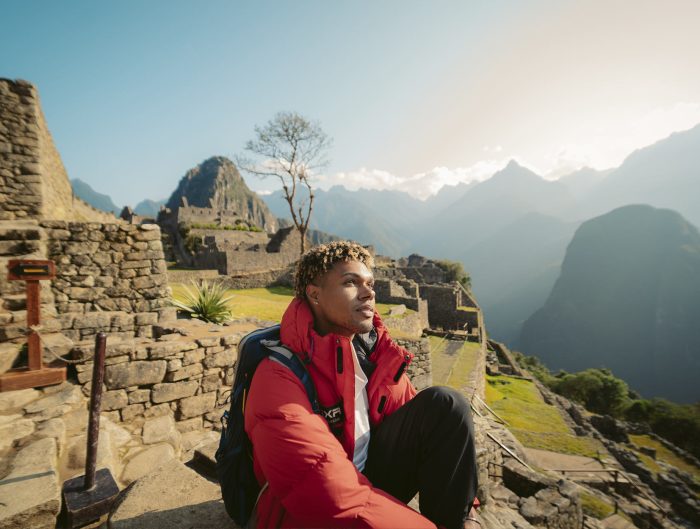


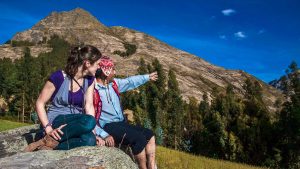
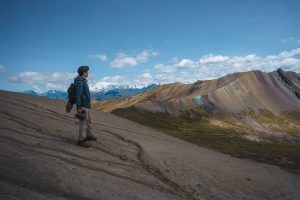
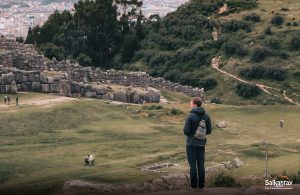
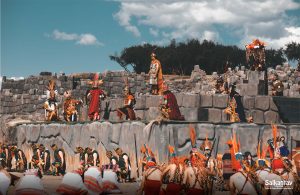

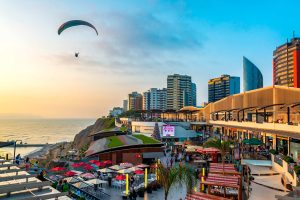

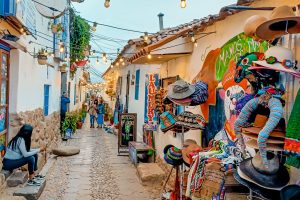

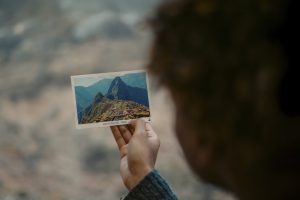
Leave A Reply